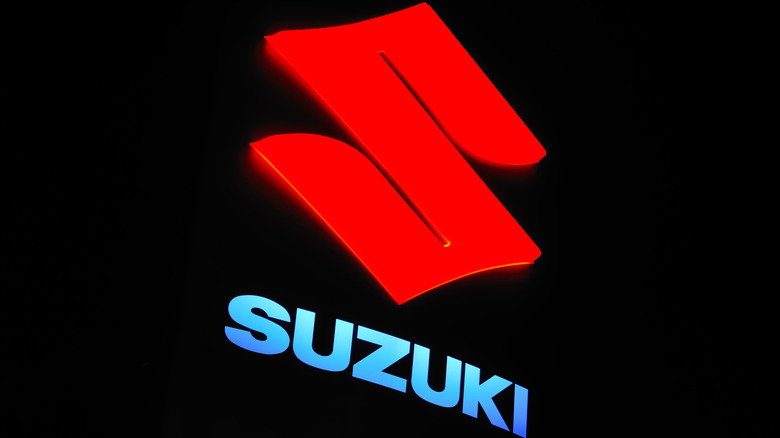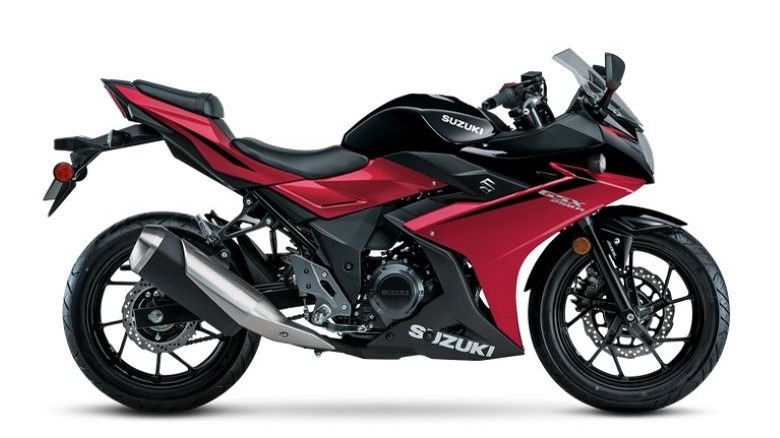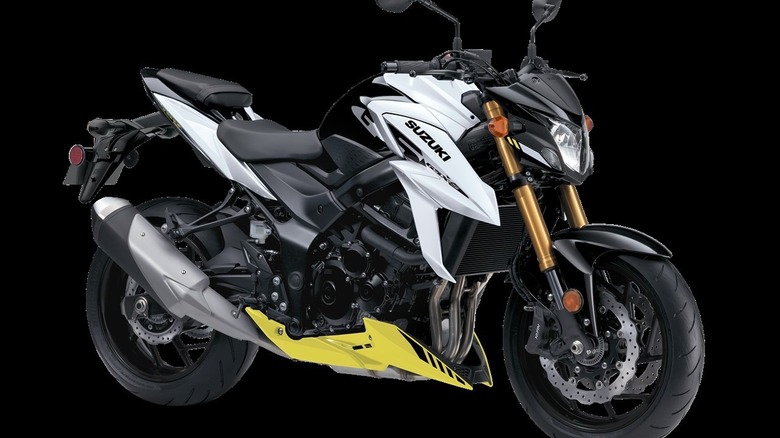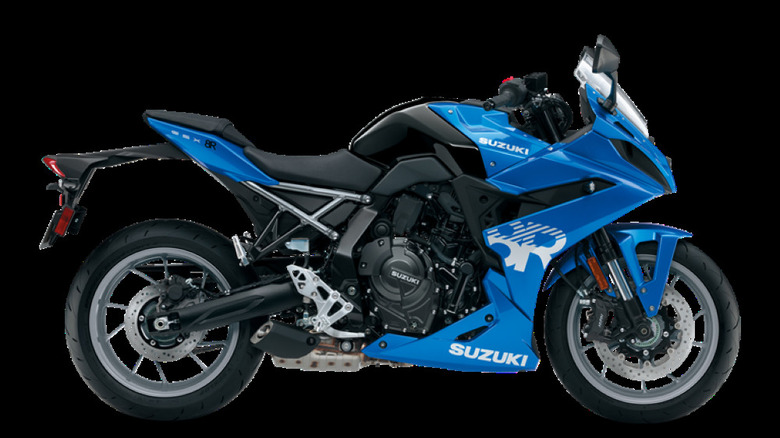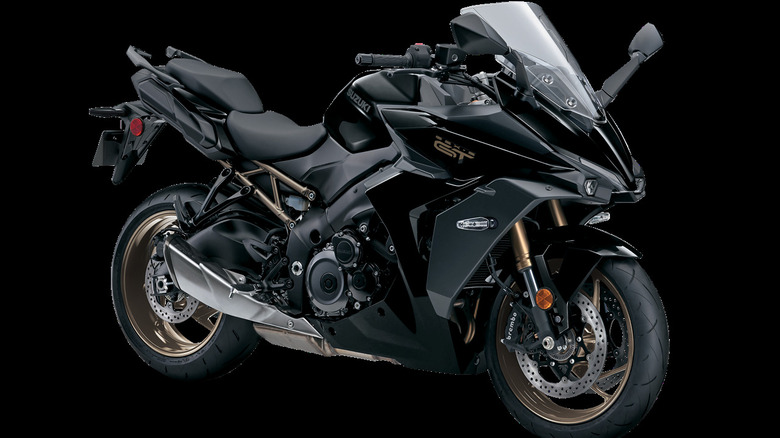Every Suzuki GSX/R Series Motorcycle You Can Buy In 2024 Ranked Cheapest To Most Expensive
The sport bike wars are as alive and well as ever. The final installment of our series on the state of the supersport world takes a peek at Suzuki's baffling but enticing line of street warriors. The big four Japanese motorcycle builders put a fighter in the ring for sportbike fisticuffs. We've outlined the prospects of Kawasaki's Ninja, the state of Honda's CBR, and an update on Yamaha's R-line.
There is one yet to enter the ring: the Suzuki GSX (-R) line of sportbikes, a featherweight fighter with a legacy in sport and street. Suzuki divided its motorcycle lines into two categories: one has "R" in the name, and the other tends not to. The origin of the R in motorcycle designations is mysterious and up for debate, but it's safe to equate it with "Race." The more 'Rs, the tighter the rider triangle, the lighter the weight, and the faster the bike. The GSX-R is Suzuki's entry in the contest, but the bike rolls deep, surrounded by an entourage of cousins, most named GSX. They're fighters, too, and they could get into the ring if they wanted to.
Suzuki's wild approach to the sport family tree has resulted in a baffling collection of GSXs and Rs, displacement sizes, design purposes, and, of course, price points. Here's an explanation of what Suzuki has been up to the past few years in our review of every Suzuki GSX/R series motorcycle you can buy in 2024, ranked cheapest to most expensive.
GSX250R ABS $5,099
The bottom of the pile is one way to frame it, but the Suzuki GSX250R ABS represents an enormous change in supersport motorcycling. For decades, superbikes vacillated between 600 cubic centimeter (cc) and 1,200 cubic centimeter (cc) engines (with a few exceptions). Today, every single line has a small-displacement, lightweight motorcycle.
The GSX250R ABS is not mean, but it looks that way. Styled after the superbike GSX-R literbikes, it takes a second glance to realize it won't bite. The bike is fully faired and aggressive. It looks like a knife ready to slice. Upon inspection, a pair of exhaust pipes was missing. The rear wheel is thinner than one would find on a GSX-R1000.
This is a 249 cc parallel-twin, single overhead cam (SOHC) motorcycle. It weighs 399 pounds (181 kilograms), and the saddle height is 31.1 inches (790 millimeters). The engine makes 25 horsepower. Suzuki seems set to capture the rising motorcyclist. It's smart; get them into the family on a bike that does all the fun stuff without outrageous speed, and usher them into the next bike up. It's a good plan, and a great way to get experience.
The caveat to this GSX250R ABS is it won't keep an intermediate rider entertained. Skills grow (as do bellies). This is one excellent beginner bike, but other bikes in Suzuki's line are in that category.
Rider Focus: Beginner; light, short riders, or riders who have never touched a motorcycle.
GSX-S750Z Series $8,549 to $9,149
The next entry in Suzuki's fight card is the GSX-750Z series. They come in several sizes and shapes and have fluctuating prices. The curious thing about the 750 is how early Suzuki jumped into the middleweight game.
The engine in question is a 749 cc in-line four double overhead cam (DOHC), which produces around 110 horsepower. These are not beginner numbers, but there is a case for this 750 being the last street bike you ever need. Suzuki's website trumpets this bike's engine donor: the GSX-R750.
The S750, regardless of sub-designation, comes in naked streetfighter style. It has modern digital displays, an ABS version at $9,149, and enough power and handling to slice up a morning commute or take the partner for ice cream. Twisty turns and twisty cones, anyone?
Unlike some manufacturers, Suzuki casts a wide net to appeal to all styles. The GSX-S750 series is a good choice for an intermediate rider. These bikes are relatively light at 470 pounds (213 kilograms), and the seat height is a mere inch taller than the 250 at 32.3 inches.
Suzuki tucks the S750, S750Z, and SD750ABS into the Street section of its website, and for good reason. Every manufacturer saves a slot in the market for naked streetfighters. Suzuki's are lean and nicely equipped at well under $10,000.
Rider Focus: Experienced novice to beginner-intermediate. A cautious and mature rider could begin on a bike like the S750 and never need to buy another for lack of power and handling.
GSX-8 Series $8,999 to $9,439
Right in the mix with the 750s is the Suzuki 800s. They, too, come in different colors and packages. We feel like we are cycling through the bikes for sale at the "Road Rash" bike shop on the Sega Genesis. If I were there pondering my next bike, I would notice that the GSX-8 series experiences some price overlap with the S750s.
The GSX-8 comes with an "R" designation and an "S" designation. Suzuki puts the S in with Street bikes, while The GSX-R moves between the supersport and sport cruise worlds. Both of the 800s get a 776 cc parallel-twin cylinder DOHC powerplant. It is similar to the S750 but has half the cylinders. Still, a respectable power-to-weight ratio of 82 horsepower to about 450 pounds keeps both models in the adequate-to-exciting categories.
The 800s are mechanically similar; wet-plate clutch, six-speeds, same engine. Suzuki provides an opportunity for fans of both styles of bike to get a similar riding experience. The GSX-800R is a fully faired riding machine, while the GSX-8S is an upright naked bike. Throw a skid plate and some knobbies on the S, and it looks like it could do a trail. Different clothes, similar people. Like the 750s, these bikes could service an entire riding career. It's a matter of taste and how you like your power.
Rider Focus: Experienced novice to intermediate. There is a long way to go up the power hierarchy, but these are bikes for people with some time in the saddle.
GSX-R600 Series $11,999
Now we're getting to the veterans of the superbike wars. The Suzuki GSX-R600 has been a linchpin combatant since the heyday of the Honda Blackbird. It is synonymous with middleweight supersport performance, and commands is a list of racing honors longer than this article.
The 600 is going strong in 2024. Every builder has an option or two tucked away in what was once the premier supersport class. At the heart of the matter is a 599 cc liquid-cooled DOHC attached to a multi-plate six-speed transmission. It's got everything a race bike needs or wants. You could ride it to the track and directly on for a session, then home. You might want to change the tires or brakes, but you don't have to.
Let's talk power. Cycle World dynoed a 2023 model at about 102 horsepower. That is a significant dip from the last years of top middle-class bikes. The legendary Yamaha R6 was in 120 horsepower territory back in 2021. Still, 100 horsepower in a 412-pound (187-kilogram) motorcycle is a serious commitment. Power like that can escape control with the twist of a wrist or a fast lane change.
That's the essence of the 600 R-class machines. Suzuki's classing nomenclature can be baffling, but if it says GSX-R on it in that order, it is likely not a motorcycle for a brand-new rider.
Rider Focus: Intermediate to advanced. The GSX-R600 and GSX-R1000 are formidable bikes in all iterations.
GSXR-750 Series $13,149
When the supersport world was less diversified, there were three main classes: 600 cc, 750 cc, and 1,000 cc high-revving in-line four-cylinder bikes. The 1,000 cc class might get chassis or handling upgrade options, but the 750 class bikes were essentially 600s with larger engines.
Suzuki is one of the few that continues to sell an R-bike in a 750 cc package. The 750 was more powerful than the 600 without the pure insanity of a liter bike, and historically, Suzuki has cherished the class. The blue-and-white streak on track or street is a bona fide legend we are glad to see live on.
The "R" comes with a lot of responsibility. The GSX-R defends its performance orientation with four-piston Brembo dual disc brakes in front. Getting grip from dual brake pads is critical to stable and efficient braking. The frame is aluminum, and the curb weight of 418 pounds shows it. Traditionally, the 750s have been in the 150 horsepower range, but manufacturers seem shy about posting power unit numbers.
There are plenty of little gadgets and features built into the package. A drive mode selector that maps performance to track or street rides complements an Engine Control Module that adjusts the engine based on rider input and conditions.
Rider Focus: Experienced beginner to expert. The GSX-R 750 may not be comfortable. It may have a steep learning curve, but it can reward and challenge even expert riders.
GSX-S1000 Series $11,699 to $14,199
Back in the Street section of the Suzuki universe, we cool off from all that R talk with the GSX-S1000 series. Here, we have a trio of bikes: The GSX-S1000 is a naked streetfighter in the vein of the S750. The S1000, S1000GT, and S1000GT+ share the 999 cc GSX-R1000 engine.
The GSX-S1000 is a commuting ninja. Short, naked, flickable, and powerful, it looks like an alien fighter ship rigged for Earth's atmosphere, replete with stalk-eyed review mirrors. It is the least expensive bike in this category at $11,699.
The GSX-S1000 GT and GT+ get their own category in the Suzuki hierarchy. They are present in the Street section but are set up for grand touring. A first glance reveals a bike as futuristic and ferocious as anything on this list, but close inspection reveals nods to comfort from the designers: detachable luggage, a thick, stepped seat for the passenger, a relaxed rider triangle, and a touring windscreen. The GT+ comes with even more, topping the class at $14,199.
The GTs are sport-touring versions of the GSX-R 1000. The GSX-S1000 is the naked version. If that power point is where you are as a rider, there are several Suzuki riding styles to choose from. There is a third GT bike we'll be hitting later. When it comes to covering the bases, Suzuki has something for everyone.
Rider Focus: Intermediate to Expert. The 999 cc GSXR-1000 engine should tell it all. These bikes are for people who are comfortable on a motorcycle.
GSX-S1000GX+ $18,499
Yes, there is another GSX-S1000 option, and it is different (and expensive) enough to deserve its own explanation. It is the sole occupant of Suzuki's "Crossover" category, which indicates bikes suitable for adventure touring.
The GX+'s 999 cc DOHC in-line four from the GSX-R1000 keeps it in the GSX-S family. What makes it a crossover is a very different rider seating arrangement and an array of options that align with adventure riding. It's got power. What else? A TFT instrument panel that allows the rider to tune options like auto and manual suspension roads. The high ground clearance and knuckle busters give a hint. This GSX-S1000 has a little in common with the GTs, but where they cruise the freeways, the GX+lends itself to the unexplored path.
It is still very much a street bike with superbike performance and characteristics that aid off-road riding, like longer suspension strokes and a slew of propriety suspension management modes. It's tall and made for adventure. Shorter riders may need to practice the one-foot-down stoplight or adjust the suspension.
Rider Focus: Intermediate to advanced. Adventure riding isn't where beginners should begin, especially on a Gixxer engine, but it's where experienced riders can have a lot of fun.
GSX-R1000 $16,499 to $18,649
The GSX-R1000 is another survivor of the superbike wars. It and its younger sibling, the GSX-R600, decorated many a track and roadway through the 2000s and 2010s. The GSX-R1000 is alive and well, and, surprise, it has the powerful engine of the GSX-R1000. Three bikes have earned that honor for 2024: the GSX-R1000, GSX-R1000R, and the GSX-R1000Z.
They're fast, race-oriented, and the inheritors of the blue and white GSX-R1000, essentially a Tron bike in real life. Rumors of 200 horsepower and 14,500 RPM redlines are true, and they are every bit as svelte, perhaps even a little pleasingly softer than the literbike competition.
The price range is because each extra digit in the bike's title includes extra goodies. The R1000R comes in a sharp blue-and-white anniversary edition. The R1000RZ includes premium suspension and brake work that pays dividends for a serious track rider. Still a civilian bike for the rides, but prepared to set splits around the local track at a moment's notice.
Rider Focus: Experienced intermediate to expert. This is a liter bike. We're glad it exists, but it probably shouldn't. Do NOT buy this bike for your child.
Hayabusa $19,599
The GSX-R1000 series is almost as real as it gets from a producer of legendary motorcycles, but there is one more. An aging but powerful heavyweight, the former champion of the world, once the fastest motorcycle of all time, and still a powerhouse in its own right, ladies and gentlemen: the Hayabusa.
We talk about superbike wars, but it is no secret that the big four manufacturers scrabbled at throats for years over who could build the fastest motorcycle. The Honda Blackbird once held the title, but the Hayabusa –Japanese for the blackbird-devouring peregrine falcon – wrenched it from them. The championship may have passed onto the Kawasaki Ninja H2R, but the Hayabusa is alive and well.
There is something appropriate about the Hayabusa's price tag of under $20,000. It is a nice cap on a line of bikes that Suzuki obviously hopes will appeal to all riders. The Hayabusa 25th anniversary edition has hit the sweet spot of curves and angles. It remains unmistakable the Hayabusa, and it's almost like the menu at a fancy restaurant; in terms of power, if you have to ask how much it has, you probably shouldn't have it.
The great speed machine of the late-aughts is keeping up with the likes of most competitors, and Suzuki has demonstrated itself to be open-minded enough to cast the net wide for riders of all types.
Rider focus: Do not attempt. Go back now. Unless you're a grisly road racer from the way back, only then might you be worthy of the Hayabusa.
Methodology
Ranking motorcycles is a highly subjective activity. Everybody rides for different reasons at all levels. When looking for a bike, sometimes the alphabet soup of Gs, Xs, Rs, and more can be exhausting. We seek to alleviate some of that complexity by ranking the bikes we rank by price. It is one of the most critical data points when buying a used vehicle, and in motorcycles, it often correlates to displacement sizes and skill levels.
We unwrapped some of the meanings behind the designations of Suzuki's sport-oriented street lines. The GSX-R tends to be race bikes all day, while the GSX and GSX-S series serve multiple purposes, from street-fighting nakeds to adventure-touring superbikes. Suzuki has something for riders of all levels.
